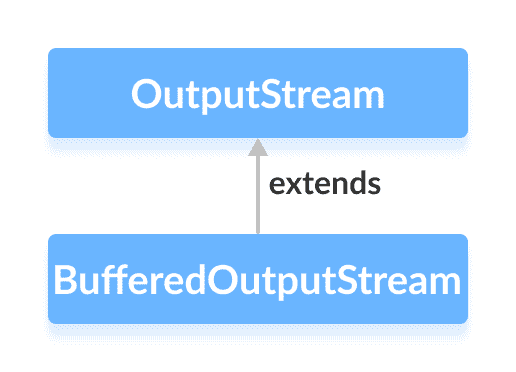原文: https://www.programiz.com/java-programming/bufferedoutputstream
在本教程中,我们将借助示例学习 Java BufferedOutputStream及其方法。
java.io包的BufferedOutputStream类与其他输出流一起使用,可以更有效地写入数据(以字节为单位)。
它扩展了OutputStream抽象类。

BufferedOutputStream的工作原理
BufferedOutputStream维护 8192 字节的内部缓冲区。
在写操作期间,字节被写入内部缓冲区而不是磁盘。 一旦缓冲区被填充或流关闭,整个缓冲区将被写入磁盘。
因此,减少了与磁盘的通信次数。 这就是为什么使用BufferedOutputStream写入字节更快的原因。
创建一个BufferedOutputStream
为了创建一个BufferedOutputStream,我们必须首先导入java.io.BufferedOutputStream包。 导入包后,就可以创建输出流了。
// Creates a FileOutputStreamFileOutputStream file = new FileOutputStream(String path);// Creates a BufferedOutputStreamBufferedOutputStream buffer = new BufferOutputStream(file);
在上面的示例中,我们使用名为file创建了名为buffer的BufferdOutputStream。
在此,内部缓冲区的默认大小为 8192 字节。 但是,我们也可以指定内部缓冲区的大小。
// Creates a BufferedOutputStream with specified size internal bufferBufferedOutputStream buffer = new BufferOutputStream(file, int size);
buffer将有助于更快地将字节写入文件。
BufferedOutputStream的方法
BufferedOutputStream类为OutputStream类中的不同方法提供了实现。
write()方法
write()- 将单个字节写入输出流的内部缓冲区write(byte[] array)- 将指定数组中的字节写入输出流write(byte[] arr, int start, int length)- 从位置start开始,将等于length的字节数写入数组的输出流中
示例:BufferedOutputStream将数据写入文件
import java.io.FileOutputStream;import java.io.BufferedOutputStream;public class Main {public static void main(String[] args) {String data = "This is a line of text inside the file";try {// Creates a FileOutputStreamFileOutputStream file = new FileOutputStream("output.txt");// Creates a BufferedOutputStreamBufferedOutputStream output = new BufferedOutputStream(file);byte[] array = data.getBytes();// Writes data to the output streamoutput.write(array);output.close();}catch (Exception e) {e.getStackTrace();}}}
在上面的示例中,我们创建了一个名为output和FileOutputStream的缓冲输出流。 输出流与文件output.txt链接。
FileOutputStream file = new FileOutputStream("output.txt");BufferedOutputStream output = new BufferedOutputStream(file);
要将数据写入文件,我们使用了write()方法。
在这里,当我们运行程序时,output.txt文件填充了以下内容。
This is a line of text inside the file.
注意:程序中使用的getBytes()方法将字符串转换为字节数组。
flush()方法
要清除内部缓冲区,我们可以使用flush()方法。 此方法强制输出流将缓冲区中存在的所有数据写入目标文件。 例如,
import java.io.FileOutputStream;import java.io.BufferedOutputStream;public class Main {public static void main(String[] args) {String data = "This is a demo of the flush method";try {// Creates a FileOutputStreamFileOutputStream file = new FileOutputStream(" flush.txt");// Creates a BufferedOutputStreamBufferedOutputStream buffer = new BufferedOutputStream(file);// Writes data to the output streambuffer.write(data.getBytes());// Flushes data to the destinationbuffer.flush();System.out.println("Data is flushed to the file.");buffer.close();}catch(Exception e) {e.getStackTrace();}}}
输出
Data is flushed to the file.
当我们运行程序时,文件flush.txt充满了由字符串data表示的文本。
close()方法
要关闭缓冲的输出流,我们可以使用close()方法。 一旦调用了该方法,就无法使用输出流写入数据。
要了解更多信息,请访问 Java BufferedOutputStream(官方 Java 文档)。

